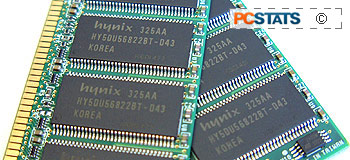UPDATE: What about AMD Athlon64
Processors?
After playing with several DDR DIMM's intended for
Pentium 4 C systems on both our Socket 754 and Socket 939 Athlon64 platforms, I
think it's safe to say that they behave very much like AthlonXP systems. Most
Athlon64 systems cannot easily reach the same motherboard speeds as their Intel
counter parts, and this means the memory cannot make up for the high latencies
with pure memory bandwidth/speed.
In fact, it seems that most high speed DIMM's do
not run very well on Athlon64 systems. Often, the RAM is unable to reach its
advertised speed, even though the motherboard has been tested higher.
As you can see from the above table of results, the
(slower rated) low latency memory can actually reach a higher overall speed,
while keeping tighter timings. All the high speed DIMM's based on Hynix memory
do quite poorly, topping out at an unimpressive 217 MHz. Unless the Athlon64
architecture changes drastically in the next little while, make sure you buy low
latency memory (2-2-2-5) for you Athlon64 system just as you would for an
AthlonXP system!
Conclusions:
While bandwidth is still very important to the Intel Pentium
4 processor, it's not as important as it once was in the days of the i845PE, and single
channel memory controllers. Thanks to the i865PE/i875P's dual channel memory controller things are much
brighter. On average, the system with the memory running at 400 MHz (5:4 memory
divider enabled) with aggressive memory timings performed 2-3% faster than the
system using high speed memory with loose timings.
While that may not seem like a lot to most people, it can make a world of a
difference to the enthusiast, especially if you're gunning for that high
score in a clan match where every FPS counts.
 It seems as if all the large memory manufacturers/suppliers are
afraid to lose face by not pumping out high speed memory modules with lax memory
timings just so they can list them in their product lines. Many enthusiasts I know,
tend to favour slower memory which allows them to run aggressive timings however.
It seems as if all the large memory manufacturers/suppliers are
afraid to lose face by not pumping out high speed memory modules with lax memory
timings just so they can list them in their product lines. Many enthusiasts I know,
tend to favour slower memory which allows them to run aggressive timings however.
One might say that the benchmarks we used were stacked
against memory that uses conservative timings, but if you think about it, games
and simple 2D applications are the programs that most consumers run where
speedy performance really
is important. That's why we ran the benchmarks we did; office environments with their servers
or work station PC are more interested in stability, and overclocking has an element of risk
involved for both hardware and software.
Athlon64 based systems act a lot like the 800 MHz FSB
Pentium 4 processors in regard to their memory bandwidth and timings when
overclocked.... but they are by no means interchangeable. From the updated
results shown above, AMD K8 processors are clearly much more sensitive to lower latency
DDR RAM, and justifiably prefer it. Much like the AMD K7
processors before it, Athlon64 processors produced the best results when overclocked with lower latency
DDR memory.
If you're in the market for new memory for your Intel
Pentium 4 system and you're only thinking about gaming performance, then you're
best bet is to get DDR which is rated to run aggressive timings. Some examples include Mushkin's PC3500 Level II
which is rated to run 2-2-2-5 at 217 MHz FSB or Corair's TwinX-3200LL which are
rated for 2-2-2-5 at 200 MHz.
If you're a newbie/novice overclocker and
would prefer to buy something that takes a little less work while still
producing good numbers on your Pentium 4 system, then by all means get some of
the high speed DIMM's that are available on the market. They're not
quite as fast as the low latency modules as we've shown, but they're much easier to set
up. Now for AMD systems; because the AthlonXP cannot hit as high speeds as the Pentium 4 in
general, it is always best to pair an AMD processor (AthlonXP or Athlon64) with nice low
latency memory for the best results.
Find out about this and many other reviews by joining the Weekly
PCstats.com Newsletter today!
Related
Articles
Here are a few other articles that you might enjoy
as well...
1. Corsair
TwinX1024-4000Pro DDR Memory Review
